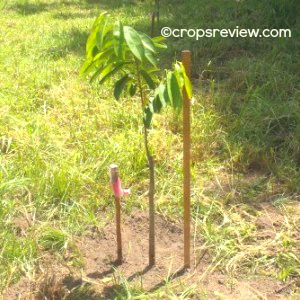Soursop or guyabano trees (Annona muricata) can be grown using bare-root plants as planting materials, including wildlings.
Bare-roots are plants in which the roots are plainly visible, as in uprooted wildlings.
Wildlings are seedlings which naturally grow on forest floors or under the canopy of crops or just anywhere as when seeds are dispersed by man, animals, and water.
The term bare-root can also apply to nursery-grown potted seedlings and clones after removing the ball of soil holding the roots.

To give an idea on how to collect and pot wildlings of guyabano, the relevant portion of Adult, Bare-root Mango Trees Can Be Transplanted is reproduced below.
This page also provides information related to what are discussed here.
In 1999, we uprooted Robusta coffee wildlings at least the size of an ordinary pencil at Monkayo, T’boli in South Cotabato.
The wildlings were trimmed of excess primary roots, moistened and packed in containers to prevent dehydration, and transported to General Santos City by jeepney without exposing them to the sun.
Travel took 2 hours and two minutes halfway through rough road. The wildlings were then potted in black plastic bags. Survival rate was 100% under shade.
The potted wildlings remained in the nursery for about 6 months and, subsequently, some were outplanted in June and in the following November to December the plants flowered.
The seedlings must have been old, similar to the so-called large planting materials or LPM.
The above procedure when applied to guyabano involves uprooting of wildlings either with hands alone or with the use of any tool to loosen the soil.
The uprooted seedlings are then planted into suitable containers like plastic bags with a size of 7 in. x 10 in. or thereabout.
After a month or so when the plants have completely recovered and have regenerated new roots, they are ready for hardening and outplanting.
However, newly uprooted wildlings can also be directly planted on the field and so save time, nursery space, labor and expense that would otherwise have been used in potting and temporary care in the nursery.
Removal of the pot and the soil which holds the roots of potted seedlings will also save space and cost in transporting seedlings.
Provided, however, that bare-root seedlings are transported moist and packed in suitable material that will prevent dehydration and unexposed to direct sun.
We normally immerse the bare-roots in or sprinkle them with water, insert them in a large plastic bag, and close the bag with a tying material.
Personal experience has shown also that for maximum survival of outplanted planting materials, either potted or bare-root seedlings or newly uprooted wildlings of guyabano, it is better to use those with heights at least 1 foot (~30 cm) from root collar.
Likewise, large bare-roots can be transplanted as in mango, molave, and other plant species.
In guyabano, we have actually tried, and succeeded, in growing the fruit crop using up to trunk size of about 2 inches (~5 cm).
To prevent rapid loss of water due to transpiration, some plants were cut back leaving only a few stubs of branches or a portion of the main stem so that they were bare of both roots and leaves.
Larger plants which were not severely pruned started fruiting in less than a year.
To increase the probability of success when bare-root planting materials of guyabano are used, the rule is that they must be planted immediately after collection because they are susceptible to drying injury.
The best time to plant is when it is raining or late in the afternoon. The night following planting seems to have a reinvigorating effect on the stressed plants.
These rules apply to other species.
With outplanted bare-roots, the most limiting factor in plant propagation and survival is water.
Daily supply must be ensured and the soil immediately surrounding each plant should be kept moist, at least until complete recovery and the plant continues to produce new leaves.
Provision of shade will further improve survival.
